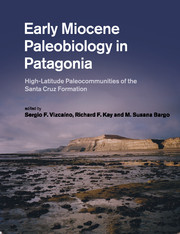Book contents
- Early Miocene Paleobiology in Patagonia
- Frontispiece
- Early Miocene Paleobiology in Patagonia
- Copyright page
- Contents
- Contributors
- Preface
- 1 Background for a paleoecological study of the Santa Cruz Formation (late Early Miocene) on the Atlantic Coast of Patagonia
- 2 Tephrochronology of the Miocene Santa Cruz and Pinturas Formations, Argentina
- 3 Absolute and relative ages of fossil localities in the Santa Cruz and Pinturas Formations
- 4 Sedimentology and paleoenvironment of the Santa Cruz Formation
- 5 Oysters from the base of the Santa Cruz Formation (late Early Miocene) of Patagonia
- 6 Ichnology of distal overbank deposits of the Santa Cruz Formation (late Early Miocene): paleohydrologic and paleoclimatic significance
- 7 Fossil plant studies from late Early Miocene of the Santa Cruz Formation: paleoecology and paleoclimatology at the passive margin of Patagonia, Argentina
- 8 Amphibians and squamate reptiles from the Santa Cruz Formation (late Early Miocene), Santa Cruz Province, Argentina: paleoenvironmental and paleobiological considerations
- 9 Diversity and paleobiology of the Santacrucian birds
- 10 Paleoecology of the Paucituberculata and Microbiotheria (Mammalia, Marsupialia) from the late Early Miocene of Patagonia
- 11 Paleoecology of the mammalian carnivores (Metatheria, Sparassodonta) of the Santa Cruz Formation (late Early Miocene)
- 12 Paleobiology of Santacrucian glyptodonts and armadillos (Xenarthra, Cingulata)
- 13 Paleobiology of the Santacrucian sloths and anteaters (Xenarthra, Pilosa)
- 14 Paleobiology of Santacrucian native ungulates (Meridiungulata: Astrapotheria, Litopterna and Notoungulata)
- 15 Paleobiology of Santacrucian caviomorph rodents: a morphofunctional approach
- 16 Paleobiology of Santacrucian primates
- 17 A review of the paleoenvironment and paleoecology of the Miocene Santa Cruz Formation
- Index
16 - Paleobiology of Santacrucian primates
Published online by Cambridge University Press: 05 June 2013
- Early Miocene Paleobiology in Patagonia
- Frontispiece
- Early Miocene Paleobiology in Patagonia
- Copyright page
- Contents
- Contributors
- Preface
- 1 Background for a paleoecological study of the Santa Cruz Formation (late Early Miocene) on the Atlantic Coast of Patagonia
- 2 Tephrochronology of the Miocene Santa Cruz and Pinturas Formations, Argentina
- 3 Absolute and relative ages of fossil localities in the Santa Cruz and Pinturas Formations
- 4 Sedimentology and paleoenvironment of the Santa Cruz Formation
- 5 Oysters from the base of the Santa Cruz Formation (late Early Miocene) of Patagonia
- 6 Ichnology of distal overbank deposits of the Santa Cruz Formation (late Early Miocene): paleohydrologic and paleoclimatic significance
- 7 Fossil plant studies from late Early Miocene of the Santa Cruz Formation: paleoecology and paleoclimatology at the passive margin of Patagonia, Argentina
- 8 Amphibians and squamate reptiles from the Santa Cruz Formation (late Early Miocene), Santa Cruz Province, Argentina: paleoenvironmental and paleobiological considerations
- 9 Diversity and paleobiology of the Santacrucian birds
- 10 Paleoecology of the Paucituberculata and Microbiotheria (Mammalia, Marsupialia) from the late Early Miocene of Patagonia
- 11 Paleoecology of the mammalian carnivores (Metatheria, Sparassodonta) of the Santa Cruz Formation (late Early Miocene)
- 12 Paleobiology of Santacrucian glyptodonts and armadillos (Xenarthra, Cingulata)
- 13 Paleobiology of the Santacrucian sloths and anteaters (Xenarthra, Pilosa)
- 14 Paleobiology of Santacrucian native ungulates (Meridiungulata: Astrapotheria, Litopterna and Notoungulata)
- 15 Paleobiology of Santacrucian caviomorph rodents: a morphofunctional approach
- 16 Paleobiology of Santacrucian primates
- 17 A review of the paleoenvironment and paleoecology of the Miocene Santa Cruz Formation
- Index
Summary
Over the past century, the Santa Cruz Formation of coastal Argentina (late Early Miocene) has yielded a remarkable collection of platyrrhine primates. With few notable exceptions, most of the specimens have been included in Homunculus patagonicus Ameghino, 1891, a stem platyrrhine. Homunculus patagonicus was approximately 1.5 to 2.5 kg in body mass, about the size of a living saki monkey (Pithecia) or a female Cebus. Molar structure indicates that the diet consisted of a mixture of fruit and leaves. A deep jaw, large postcanine tooth roots, large postglenoid processes and moderately large chewing muscle attachments (i.e. massive zygomatic arches, sculpted temporalis origins) suggest that physically resistant foods were key components of the diet. Heavy tooth wear suggests large amounts of ingested silica or exogenous abrasives. Incisor morphology suggests that exudate harvesting may have been part of the behavioral repertoire, although not a specialization. The canines were small, providing no evidence of sclerocarpic foraging. Canines were sexually dimorphic, suggesting that the taxon experienced some intrasexual competition rather than being solitary or pair-bonded. Brain size was small and the frontal cortical region was proportionately small. From the small size and structure of the orbits, the structure of the organ of hearing, the reduced olfactory fossae and the relatively large infraorbital foramina, we infer that Homunculus was probably diurnal, with acute vision and hearing, but with a poor sense of smell and little reliance on tactile vibrissae. Homunculus was an above-branch arboreal quadruped with leaping abilities. The semicircular canals show evidence of considerable agility, reinforcing the inference of leaping behavior. The overall locomotor repertoire is not unlike that of the forest-dwelling extant saki monkey Pithecia. Considered together, the mosaic of dietary and locomotor morphology in Homunculus suggests that Homunculus inhabited an environment – as compared with earlier Colhuehuapian and Pinturan primate habitats – shifting towards greater seasonality in patchy forests near river courses.
- Type
- Chapter
- Information
- Early Miocene Paleobiology in PatagoniaHigh-Latitude Paleocommunities of the Santa Cruz Formation, pp. 306 - 330Publisher: Cambridge University PressPrint publication year: 2012
- 18
- Cited by



